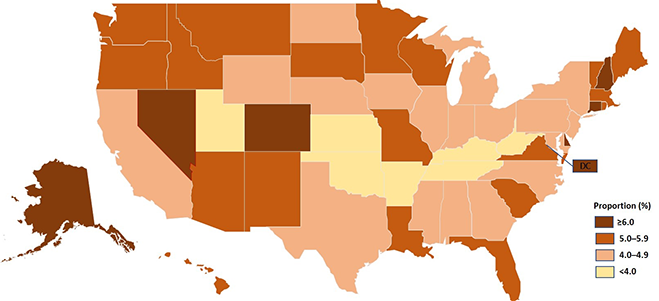US States Vary in How Drinking Alcohol Affects Cancer Diagnoses and Deaths

PROPORTION OF NEW CANCER CASES LINKED WITH DRINKING ALCOHOL BY STATE FOR MEN AND WOMEN, 2013-2016
Drinking alcohol has been linked with both developing and dying from several types of cancer. That’s why the American Cancer Society’s (ACS) Guideline for Diet and Physical Activity for Cancer Prevention states that it is best not to drink alcohol. A new study by ACS researchers supports this recommendation.
The study, published in Cancer Epidemiology, found that alcohol accounts for a “considerable proportion” of cancer diagnoses and deaths in all US states. From 2013 to 2016, drinking alcohol was tied to more than 75,000 new diagnoses of cancer and almost 19,000 deaths from cancer each year.
The study fills a research gap by providing up-to-date estimates about the link between drinking alcohol and cancer across all 50 states and the District of Columbia. New England and Western states (except Utah), in general, had the highest estimated proportion of new diagnoses and deaths attributed to drinking alcohol, while Midwestern and Southern states generally had the lowest estimates.
“The value of having state-specific information is that it allows each state’s health care providers and public health staff to prioritize education for the community as well as health policies that have been shown to help reduce the number of people who drink alcohol and the number of drinks they have,” said Farhad Islami, MD, PhD, senior ACS author of the study.
States with the highest proportion of cancer cases and deaths related to alcohol
The study found Delaware had the highest proportion (6.7%) of new diagnoses of cancer related to drinking alcohol in men and women age 30 and older. Each of these other states also had more than 6 out of 100 (6%) new cancer cases linked with drinking alcohol:
- Nevada
- Colorado
- New Hampshire
- Alaska
- District of Columbia
Delaware and Nevada also had the highest proportion of cancer deaths linked to drinking alcohol. In these states, alcohol had a role in more than 4 out of 100 (4%) deaths from cancer.
States with the lowest proportion of cancer cases and deaths related to alcohol
The study found that Utah had the lowest proportion (2.9%) of new cancer diagnoses related to drinking alcohol in both men and women age 30 or older. Each of these states also had fewer than 4 out of 100 (4%) new cancer cases linked with alcohol use:
- West Virginia
- Oklahoma
- Arkansas
- Kentucky
- Kansas
- Tennessee
Utah also had the lowest proportion of cancer deaths linked to drinking alcohol. In that state, alcohol had a role in less than 2 out of 100 deaths from cancer.
Cancer types with the strongest links to alcohol
Drinking alcohol had a stronger connection with certain types of cancer. The highest links were estimated for:
- Mouth (oral cavity) and throat (pharyngeal) cancer, with almost 50% of new diagnoses related to drinking alcohol in most states. From 2013 to 2016, that added up to about 91,000 people.
- Voice box (laryngeal) cancer, with about 30% of new diagnoses related to drinking alcohol. During the years studied, that added up to almost 15,000 people. Of those, men had about 8 times as many cases of laryngeal cancer as did women.
- Breast cancer in women, with about 12% of new diagnoses related to drinking alcohol. That added up to about 116,000 women. Breast cancer accounts for about 75% of all alcohol-related cancers diagnosed in women. For all cancers linked with alcohol, breast cancer had the biggest differences between the states. In Delaware, about 3 times as many cases of breast cancer were linked with alcohol as in West Virginia.
State-level health policies can help reduce the harm from drinking alcohol
Recent evidence suggests that restricting the amount of alcohol people drink is linked with a reduction in cancer death rates. Plus, with each alcohol-free year a person has, the risk of cancer continues to decrease.
The study authors note that restrictions on where and when alcohol is sold can help reduce the number of people who drink and the amount people drink. These include:
- Limiting the number of hours or days stores may sell alcohol
- Reducing the number of liquor stores in an area
- Increasing efforts to reduce sales to minors
Other actions that can help reduce harmful effects from drinking alcohol include:
- Increasing excise taxes, which may lead to higher prices of alcoholic drinks and a decline in the amounts people buy and drink
- Restricting marketing and alcohol-industry sponsorship of youth events
What’s more, many people still may not be aware of the potentially harmful health effects of drinking, including the increased risk of cancer. Health care providers and other heath professionals can help educate the public about this, citing resources such as the American Cancer Society Guideline for Diet and Physical Activity for Cancer Prevention.



